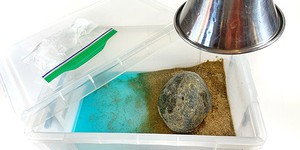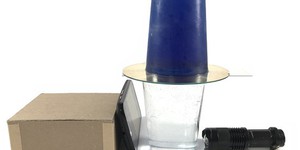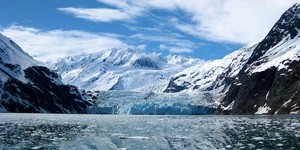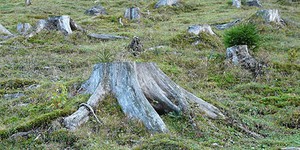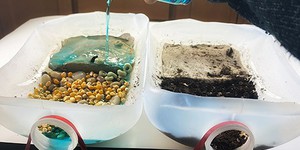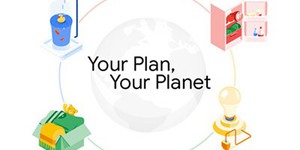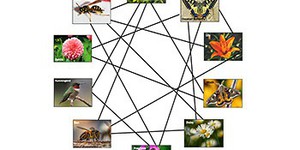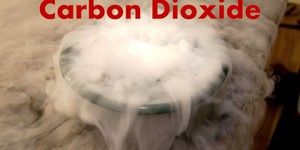Environmental Science Lesson Plans (20 results)
As humans we are part of the environment. With over 7.5 billion of us on Earth, our combined actions also have a big impact on the environment. As long as we are aware of the impact, we can do things as individuals, and working together as groups, to lessen the detrimental impact of billions of people. Explore important topics like air quality, water quality, the effects of climate change, and many others to make informed decisions about caring for our planet.
|
Select a resource
Sort by
|
Lesson Plan
Grade: 6th-8th
11 reviews
Earth is a planet full of water. 70% of its surface is covered with water in oceans, lakes, rivers, and more. Water on our planet can also be found in the atmosphere and underground. In this lesson, students will explore how water is continually cycled among land, the oceans, and the atmosphere. As students build a physical model of the water cycle, they will be able to simulate and observe evaporation, condensation, precipitation, and other water cycle processes in real-time.
Remote…
Read more
NGSS Performance Expectations:
Lesson Plan
Grade: 6th-8th
1 review
Why is the ocean vital to our planet? There are many reasons, but one important one is that the ocean is a major player in regulating our weather and climate through currents. In this lesson plan, your students will model ocean currents with cups, water, and food coloring, and explore how temperature and density differences set deep ocean waters in motion to create a global oceanic circulation system.
Read more
NGSS Performance Expectations:
Lesson Plan
Grade: 6th-8th
3 reviews
Global warming, pollution, and deforestation are just a few examples of how human actions affect our planet. How can we reduce our impact on the environment? In this lesson, students will find out by using an online tool called
Your Plan, Your Planet.
Based on their findings, students will come up with their own action plans aimed at reducing their personal ecological footprint and assess its effectiveness after implementation.
Read more
NGSS Performance Expectations:
Lesson Plan
Grade: 5th-8th
2 reviews
Do sea levels rise when ice melts? Does it matter whether the ice is on land or in the ocean? Students design an experiment to find out. They collect data, graph their results, and interpret their findings. Along the way, they learn about density, displacement, and climate change.
Read more
NGSS Performance Expectations:
Lesson Plan
Grade: 6th-8th
3 reviews
Forests are the green lung of the Earth and home to millions of different plant, fungi, animal, and bacteria species. Unfortunately, today many forests are threatened by deforestation, which causes significant biodiversity loss. Ongoing reforestation efforts across the world intend to counteract the effects of deforestation. As planting trees by hand does not scale well, machines on the ground, as well as flying drones have been developed to help plant tree seedlings or seeds. In this lesson,…
Read more
NGSS Performance Expectations:
New
Lesson Plan
Grade: 6th-9th
In this lesson plan, students will model the complex biologic manufacturing process. First, they will model the cellular expansion process that occurs in a bioreactor. Then, students will lyse the cells to isolate the proteins from the dyed cell debris. Lastly, they will model the advanced filtration process to purify proteins so they can be used as medicines.
Read more
NGSS Performance Expectations:
Lesson Plan
Grade: 4th-8th
7 reviews
The problems with using fossil fuels starts with extraction. In this activity, students "mine" chocolate chips out of cookies to demonstrate the effects mining can have on habitats.
Read more
NGSS Performance Expectations:
Lesson Plan
Grade: 3rd
Students might think rain gardens are only there to make an urban area look nice. In this lesson, students will make mini rain gardens and discover how these can filter out pollution and soak up excess rainwater. Will they find how rain gardens help prevent natural disasters? Try out this fun lesson and see!
Read more
NGSS Performance Expectations:
Lesson Plan
Grade: 5th
5 reviews
How do our everyday actions contribute to our ecological footprint? Can we change our individual actions to be more environmentally friendly and create a more sustainable lifestyle? In this lesson, students will evaluate their own environmental impact using an online tool called
Your Plan, Your Planet,
and evaluate simple ways to reduce their ecological footprint as an individual or community.
Read more
NGSS Performance Expectations:
Lesson Plan
Grade: 2nd
3 reviews
Pollination and seed dispersal are both crucial processes in a plant's reproduction cycle. These processes are helped along by many factors, including different animals. For instance, some animals disperse the plant seeds, while others transfer pollen from one flower to another. In this lesson plan, students will investigate the interdependence between plants and animals for pollination and seed dispersal by creating interdependence webs out of yarn. Based on their created interdependence webs,…
Read more
NGSS Performance Expectations:
Lesson Plan
Grade: 5th-12th
3 reviews
Where does CO₂ come from and how does excess carbon dioxide in the atmosphere affect the ocean and aquatic life? In this lesson students are introduced to the carbon cycle and explore pH and acidification with hands-on experiments. They then connect their experimental data with real-world data to evaluate claims about carbon dioxide and ocean acidification. Finally, students are introduced to how different companies and research groups are using green chemistry to build carbon capture…
Read more
|

